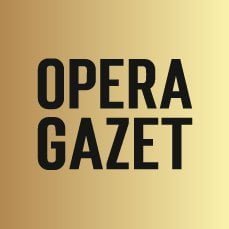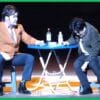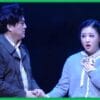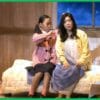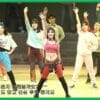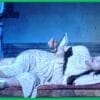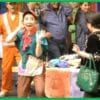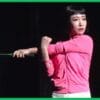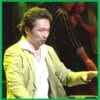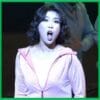A LUCKY DAY
운수좋은 날
KOREAN OPERA IN TWO ACTS
Libretto and music by Park Ji Woon (박지운). From a story by Hyun Jin-Geon.
INTRODUCTION
(Partly taken from the presentation booklet of the 2013 version)
The novel by Korean writer Hyun Jin-geon “A Lucky Day ” (운수 좋은 날), published in 1924 and considered one of the classic modern tales, is reborn as an opera. The Noble Art Opera Company (director Shin Seon-seop) has produced and staged a new opera inspired by the novel, which expresses the coldness of reality and human weakness, the subject of the original story, with clear and concise lines and classically inspired music. According to the director, “the audience will be able to perceive the perfect harmony between literature and music, in the union between Korean feelings and the luxurious music of traditional European operas.”
The operatic version has some differences from the original. In the novel, the rickshaw puller Kim Jae-soo hasn’t seen any customers for ten days due to bad luck. Apparently, the situation changes when he manages to earn a large sum of money in just one day. The man returns home after celebrating his windfall at a bar, only to find his sick wife already dead. Old Kim ‘s seemingly lucky day ends in the worst possible way.
The opera is set in the 80s of the 20th century, and modifies some elements accordingly: for example, Kim Jae-soo is initially a young university student. His meeting with his future wife Ami is also introduced in the first act. The connection with the novel occurs in the second act set ten years later, where Jae-soo unexpectedly manages to get the money needed to operate on his wife who is suffering from cancer. The plot also features the very young daughter of the two, Sook -he, and a seemingly “bad” character, President Park, Ami’s ex-boyfriend.
Composer and conductor Park Ji-Woon (박지운), who wrote the music and libretto, studied with Jeong Myung-Hoon, among others, at the Accademia di Santa Cecilia in Rome.
The music
Contrary to what one might expect from an opera born in such a “far away” nation, the music fits perfectly into the tradition of Western opera, especially Italian opera, making “singability” its most evident characteristic. Gifted with a very happy melodic inventiveness and great compositional skill, Park Ji-woon constructs this short opera (lasting just over an hour and twenty minutes) in a traditional way, maintaining closed forms such as arias and duets, without however renouncing the use of a certain number of leitmotifs that act as unifying elements. The first one we hear appears right at the beginning, in the form of a light waltz, characterizing the first meeting between the two protagonists. Its subsequent appearances will express the memory of these happy moments. Another important theme is associated with Jae-soo ‘s love for Ami, which appears hinted at in the first scene, only to be taken up again in a complete form in Jae-soo ‘s aria, at the beginning of the second scene of the first act. The theme of “Kyrie Eleison” is associated with Ami and her suffering, which also closes the opera. The theme sung in his debut aria (in the Rossini style) corresponds to President Park, in the first scene of the second act, while little Sook-hee is characterized by two different themes, also presented in her aria (second scene of the second act). From a structural point of view, we observe how an overture or a prelude is completely absent, while two interludes are planned between the scenes of the two acts. Symmetrically, the chorus presents two interventions, one at the end of the first scene of the second act and one at the beginning of the first scene of the second act.
Regarding the style, the composer evidently takes up the great Italian tradition, avoiding however the easy use of folkloristic elements, “suggesting” in some cases the Korean atmosphere rather than reproducing it explicitly. There is no lack of attention to “pop” tendencies, markedly in the chorus that concludes the first scene of the first act (“gymnastics” scene). The confident conduct of the orchestra and the voices, and in general the excellent success of the work indirectly give credit also to the Roman school of Santa Cecilia.
The versions
The first version of the opera available on the internet is dated 2011, other versions are from 2013 (in my opinion the best), 2015 and the much more recent ones from 2020 and 2021, plus a semi-staged version from 2022 (see link on the next page). Compared to the “first version” (meaning actually those from 2011/2013), in the subsequent ones there are some small changes, which I have tried to report in the libretto. The most obvious is the moving of the “Kyrie Eleison”, sung in the first versions by Ami as an interlude between the two acts, to the finale of the opera. In this case the soprano is accompanied by three dancers, absent in the first versions, where the stage appears practically empty with a single spotlight pointed at the singer. In the recording of the 2011 version the two short orchestral interludes are missing, we do not know whether they were actually performed or not. Another very evident difference in the 2013 edition is the attribution of the role of Sook-hee, originally a mezzo-soprano, to a teenager – white voice. While the original choice is certainly preferable from a vocal and musical point of view, the scenic impact is decidedly more effective in the second case. The scenography is also more refined and detailed in the 2013 version compared to the subsequent ones, mostly resolved with simple projections. Further small differences such as the presence/absence of President Park in the final scene are indicated in detail in the libretto. Finally, it is necessary to observe how the technical quality of both the audio and video recordings is clearly superior in the 2020 and 2021 versions compared to the previous ones. In fact, the 2011 edition appears particularly poor from the point of view of video quality, while in the 2013 version (with terrible audio) a small but annoying audio/video mismatch is present starting from the second act.
Characters
Jae-soo …………………………… Tenor
Ami ……………………………… Soprano
Sook -he, their daughter……………… Mezzosoprano
President Kim ………………… Baritone
An elderly passerby …………… Tenor
A student ……………………. Baritone
A gymnastics instructor…… (M)
A saleswoman…………………… (M)
A passerby…………………….. (M)
Passers-by, shopkeepers, young athletes, children, etc.
Interpreters
Below are the main interpreters of the video editions available on the internet:
| Year | Ami | Jae-soo | President Kim | Sook Hee |
| 2011 | SEO Hwa-ran 서활란 | Kang Shin-mo 강신모 | Park Jun Min 新图 | Lee Seong -mi 이성미 |
| 2013 | Min Eun-hong Theme | Jung Neun-hwa 정능화 | Park Jun Min 新图 | Kim Lin 김린 |
| 2015 | Oh Eun-kyung 오은경 | Jung Neun-hwa 정능화 | Park Jun Min 新图 | ? ? |
| 2020 | Kim Shin Hye 김신혜 | Jeon Byung -ho 전병호 | Park Jun Min 新图 | Oh Min-jin 고민진 |
| 2021 | Yang Geun-hwa 양근화 | Jeon Byung -ho 전병호 | Kang Kyun-won 강경원 | Oh Min-jin 고민진 |
Link to view versions 2011, 2013, 2015, 2020, 2021
https://www.youtube.com/watch?v=fcVGKvr3ECg
https://www.youtube.com/watch?v=rk235-igNhY
https://www.youtube.com/watch?v=tqa4WQEpiBo
https://www.youtube.com/watch?v=1B_cIMYj5y8
https://www.youtube.com/watch?v=urjMdTml2TY
